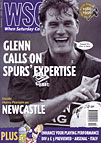 The atmosphere at football matches isn't what it used to be
The atmosphere at football matches isn't what it used to be
Another season, another FA committee may be in the offing. They’ve looked into bungs and tax fiddles (investigations so thorough and complex that we’re still waiting for definitive conclusions a couple of years later), now it’s the turn of the teams of marketing managers to look into the atmosphere or, rather, the lack of it, at grounds on matchdays.
Supporters responding to the latest annual Premiership survey identified this as one of their main concerns, which will come as no surprise to anyone who has been to a football match in recent times. The FA’s investigators will have their work cut out in coming up with a remedy, though, simply because it would seem to be an irreversible effect of the changes in football culture brought about by the imposition of all-seater stadia. Seated spectators will never be able to replicate either the noise generated by crowds packed together on standing terraces, nor that feeling of being part of a single entity unified, for better or worse, by a common cause.
Clubs know this, of course, and have been actively working to re-shape the matchday experience for several years, though their work, sad to say, is still far from complete. The model fan for the future is purely and simply a consumer, spending freely in the club shop (‘buy the replica shirt, help to pay Fabrizio’s wages’), forking out for a season ticket, and, above all, receiving, not contributing to, the entertainment being played out in front of them (to be acknowledged with polite applause and definitely no swearing).
From the moment they arrive in the stadium, supporters are having their fun packaged for them: before the game and at half-time the DJs’ blather is fitted around thumping, bombastic songs that are supposed to gets rows A to Z clapping in unison, corners and goals are now often greeted with Phantom of the Opera organ fanfares as conformation that something exciting has happened.
The effect is to deaden rather than increase the atmosphere, because fans can’t hear themselves above painfully loud PAs (an effect of the Hillsborough inquiry’s criticism of inaudible tannoy announcements, taken to ridiculous extremes), so as soon as the music starts they stop shouting and chanting. The effect is a hellish cross between a 1950s holiday camp and a Bryan Adams concert.
This outlook informs the club’s attitude towards pre-match and half-time entertainment, too, of course. Even accepting that the composition of the typical football crowd, at the bigger clubs at least, has changed significantly within the last decade, it is hard to see quite what new entertainment could be provided that would be guaranteed to attract spectators.
People won’t be put off from going to a match by whatever is staged at half-time, but nor will they be lured to a stadium by the prospect of fifteen minutes of entertainment if they’re basically uninterested in the football.
All manner of gimmicks have been tried down the years, particularly when a new commercial manager is keen to show that he’s on the case: police dogs leaping through burning hoops, chimpanzee tea parties, sky drivers landing feet first in the centre circle, or sometimes headfirst in the car park. Occasionally it’s diverting, more often it’s a cast iron excuse for the crowd to turn away from the pitch and talk amongst themselves for fifteen minutes.
Over time the atmosphere may develop in all-seater stadia as people get used to them (sitting down doesn’t seem to hamper fans in Spain or Italy). But the process can’t be speeded up by the clubs resorting to the methods used of late in basketball and ice hockey, sports whose fan culture, in this country at least, is still in its infancy.
It’s just a guess, but don’t be surprised if the final recommendations don’t stretch much further than variations on the staple ingredients of the Saturday night variety show – dancing girls, acrobats and ‘funny men’. And that in the next survey respondents will be demanding their removal.
Clubs may still feel obliged to pay attention to what supporters tell them, but that is less likely to be the case in the future as television tightens its grip on the game. The crowd atmosphere of old may return one day, though, in ersatz form, if we reach the point where fans are paid to turn up to make noise, to sing and cheer and maybe boo, to add ‘colour’ to a televised match, so that the armchair viewer won’t feel inclined to switch over. The day when Premiership marketing departments devote time and energy to thinking up ways of keeping the channel-hopping punter interested may not be too far away.
From WSC 116 October 1996. What was happening this month